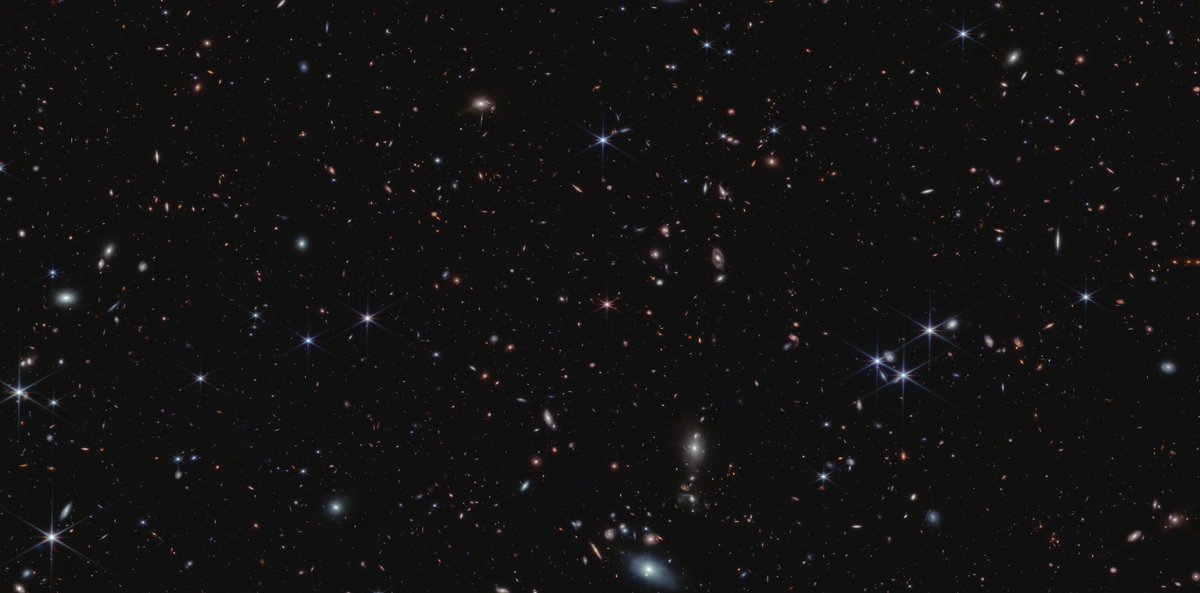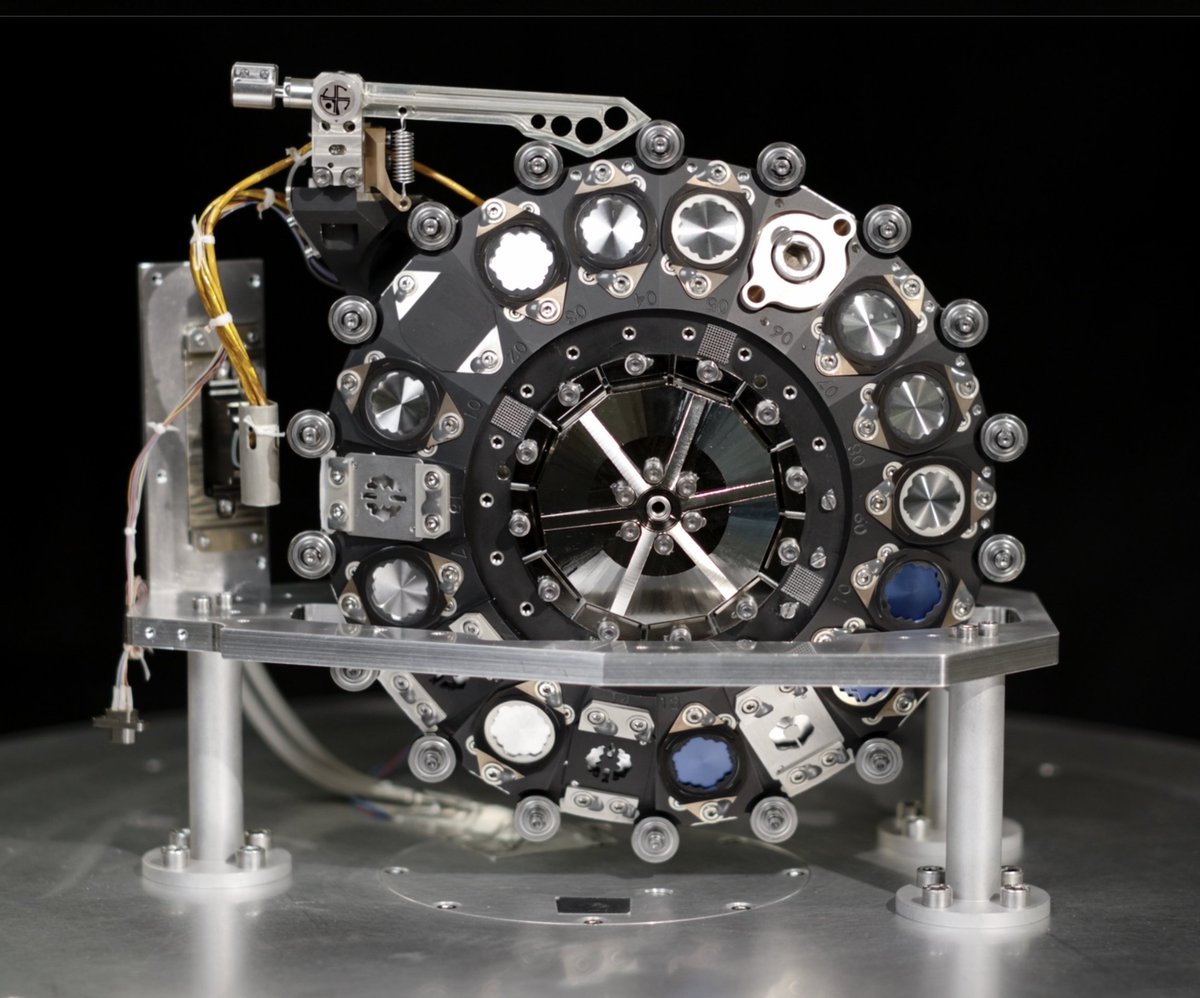Discover and read the best of Twitter Threads about #WebbSeesFarther
Most recents (16)
🆕 This Webb view contains more than 20,000 galaxies. Researchers anchored their observations on quasar J0100+2802, an active supermassive black hole that acts like a beacon. Read more: 🔗 esawebb.org/images/EIGER1/ or 🧵👇 

The quasar is at the centre of the image, and appears tiny and pink with six prominent diffraction spikes, acting like a flashlight, illuminating the gas between it and the telescope. 1/6
The team studied 117 galaxies, about 900 million years after the #BigBang. They focused on 59 galaxies in front of the quasar, some of which can be seen here: esawebb.org/images/EIGER2/ 2/6
1/ 🆕 Webb reaches new milestone 📍 in the quest for distant galaxies, having discovered some that date back to less than 400 million years after the #BigBang 🎇 The light from these galaxies has taken more than 13.4 billion years to reach us. 

2/ “It was crucial to prove that these galaxies do, indeed, inhabit the early universe. It’s very possible for closer galaxies to masquerade as very distant galaxies,” said astronomer and co-author Emma Curtis-Lake from @UniofHerts UK
@UniofHerts 3/ The observed region in this image is 15 times larger than the deepest infrared images produced by @HUBBLE_space yet is even deeper and sharper at these wavelengths.
1/ 🆕 The Southern Ring Nebula comes into new view, as we combine near- and mid-infrared light from three filters from the Near-Infrared Camera #NIRCam and Mid-Infrared Instrument #MIRI on Webb. Read on 🧵👇 

2/ In this image, Webb’s image of the Southern Ring Nebula highlights the very hot gas that surrounds the central stars. This hot gas is banded by a sharp ring of cooler gas, which appears in both images. 

3/ In this image, Webb traces the star’s scattered outflows that have reached farther into the cosmos. Most of the molecular gas that lies outside the band of cooler gas is also cold. It is also far clumpier. Read about these images here: esawebb.org/images/souther… 

1/ 🆕 Webb has captured a portion of the dwarf galaxy Wolf–Lundmark–Melotte (WLM) using #NIRCam. The image demonstrates Webb’s remarkable ability to resolve faint stars outside the Milky Way. 

2/ The galaxy lies roughly 3 million light-years away and was selected for observations as its gas is similar to that which made up galaxies in the early Universe.
3/#WebbSeesFarther This image shows this portion of the dwarf galaxy captured by Spitzer's Infrared Array Camera (left) and Webb's Near-Infrared Camera (right) 🆒 

1/ Webb turns its eye close to home by capturing its first image of Neptune, revealing the ice giant planet in a whole new light. This is the clearest view of this peculiar planet’s rings in more than 30 years. Read more:
esawebb.org/news/weic2214/
esawebb.org/news/weic2214/

2/ The new image, taken by Webb’s Near-Infrared Camera (NIRCam), shows the crisp view of the planet’s dynamic rings. The Webb images also clearly show Neptune’s fainter dust bands.
3/ Methane gas found inside Neptune is so strongly absorbing that the planet is quite dark at Webb wavelengths (0.6 to 5 microns) except where high-altitude clouds are present. Such clouds are prominent as bright streaks and spots, which reflect sunlight.
What you see here is a transmission spectrum made from a single observation using Webb’s NIRISS instrument. Let's take a closer look at it 👇 

A transmission spectrum is made by comparing starlight filtered through a planet’s atmosphere as it moves across the star, to the unfiltered starlight detected when the planet is beside the star 👇
🔴 Each of the 141 data points (white circles) on this graph represents the amount of a specific wavelength of light that is blocked by the planet and absorbed by its atmosphere 👇
📢#Webb reveals details of the Southern Ring planetary nebula that were previously hidden, helping us better understand how stars evolve and transform their environments. Read more here: esawebb.org/news/weic2207/ or below 👇#WebbSeesFarther 

Some stars save the best for last 💥 Planetary nebulae are the shells of gas and dust ejected from dying stars — making for a spectacular view. Since they exist for tens of thousands of years, observing such a nebula is like watching a movie in exceptionally slow motion 👇
Two stars, which are locked together in a tight orbit, shape the local landscape of this planetary nebula. Webb's infrared images feature new details in this complex system 👇
📢 #Webb reveals steamy atmosphere ♨️ of exoplanet WASP-96 b, capturing the distinct signature of water 💧 along with evidence for clouds & haze — the most detailed measurements of this kind to date. Read more here: esawebb.org/news/weic2206/ or below 👇 #WebbSeesFarther 

WASP-96 b is a hot, puffy gas giant planet orbiting a distant Sun-like star. On 21 June, Webb’s #NIRISS measured light from the WASP-96 system for 6.4 hours as the planet moved across the star 👇
Encore 2h environ avant de voir les autres photos !
(Pitié ne mettez plus la musique 🤪🙏😅)
Ça se passe ici par ex. :
esa.int/ESA_Multimedia…
Mais il y a plein de chaînes Twitch ou YouTube qui feront des reacts en live aussi, et plein de comptes Twitter comme moi
🤩 Hype #JWST
(Pitié ne mettez plus la musique 🤪🙏😅)
Ça se passe ici par ex. :
esa.int/ESA_Multimedia…
Mais il y a plein de chaînes Twitch ou YouTube qui feront des reacts en live aussi, et plein de comptes Twitter comme moi
🤩 Hype #JWST
1/ 📢 This is an image mosaic of 18 randomly organised dots of starlight, the product of #Webb 's unaligned mirror segments all reflecting light from the same star back at Webb's secondary mirror and into #NIRCam's detectors. Thread 👇 with a surprise at the end! 



2/ The mosaic was created by pointing the telescope at a bright, isolated star in the constellation Ursa Major known as HD 84406, chosen specifically because it's easily identifiable and not crowded by other stars of similar brightness, which helps to reduce background confusion
Taking #Webb's temperature 🌡️ 5 new temperature monitoring points have been added to the NASA website to track cooling and status of the instruments during the post L2 arrival commissioning process. Let's have a look at them 👇
1/ Temperature control is a vital aspect of #Webb 's design, engineering and operations. On the page you can see 2 "hot side" and 2 "cold side" temperatures and a set of bellweather instrument temperatures
1/ The hexagonal shape enables a roughly circular, segmented mirror with "high filling factor and six-fold symmetry." High filling factor just means the segments fit together without gaps, which would not be the case if the segments were circular
As #Webb is going through the focusing of its mirrors, let's look into what this process entails. #WebbSeesFarther 👇
1/ #Webb's 18 hexagonal mirrors have already been unfolded a while back, but now it's time for a more precise alignment so they point in exactly the same direction 🎯 and deliver sharp images.
📷 NASA/Chris Gunn
📷 NASA/Chris Gunn

2/ These corrections are made through a process called 〰️ wavefront sensing and control, which senses and corrects any errors in the telescope's optics, aligning the mirrors to within tens of nanometres
1/ The Mid-InfraRed Instrument #MIRI is one of 4 instruments on the James #Webb Space Telescope. The only mid-infrared instrument in its instrument suite. #WebbSeesFarther
📷 NASA/ Chris Gunn
📷 NASA/ Chris Gunn

2/ Thanks to state-of-the-art instrument design and components, it will deliver mid-infrared images and spectra with an unprecedented combination of sharpness and sensitivity. #WebbSeesFarther
OK, Internet. Are you ready for our gallery "The Beauty of the @NASAWebb @ESA_Webb MIRI Instrument Filter wheel"? Because it *is* beautiful, and @mpi_astro is quite proud of contributing to that amazing space telescope! Let's start with the classic face-on look. 1/ 

Also available in the Roy Lichtenstein (?) version. (OK, this is actually the 3D design by @mpi_astro and @ZEISS_Group, taken from this 2005 press release. We've been working for a long time on this!) 

With that amount of elegance and beauty, you won't be surprised to learn that the MIRI filter wheel has been doing some modelling gigs. Here it is as one of the faces of the IAU's strategic plan 2020-2030. 3/
1/ While everyone's eyes were on the shield tensioning, the Mid-Infrared Instrument (MIRI) provided by @esa for #Webb also had an important milestone: unlocking the Contamination Control Cover, which had to be locked for launch.
🔗 blogs.nasa.gov/webb/2022/01/0…
🎥 ESA/ATG medialab
🔗 blogs.nasa.gov/webb/2022/01/0…
🎥 ESA/ATG medialab
@esa 2/ After successfully completing the tests and unlocking the cover, the instrument control electronics were then powered off before the next steps on the sunshield tensioning activities.
@esa 3/ This key step for MIRI was monitored remotely by team members in Europe, ready to provide assistance if it were needed.







